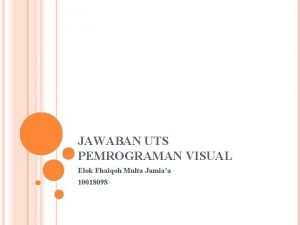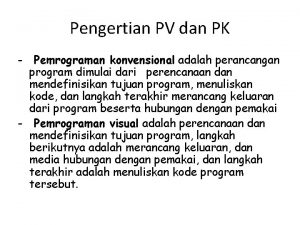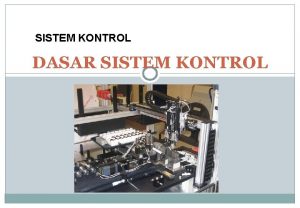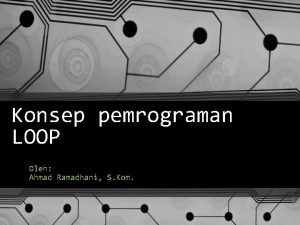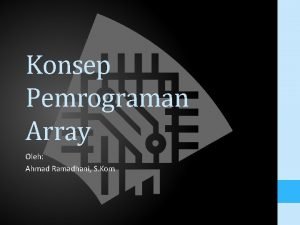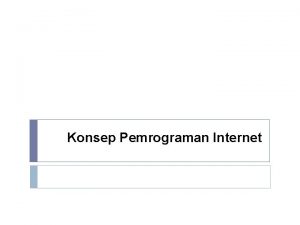Konsep pemrograman LOOP Oleh Ahmad Ramadhani S Kom









- Slides: 9

Konsep pemrograman LOOP Oleh: Ahmad Ramadhani, S. Kom.

Loops have as purpose to repeat a statement a certain number of times or while a condition is fulfilled. Salah satu kelebihan computer dibandingkan dengan manusia adalah kemampuannya untuk melakukan istruksi berulang kali tanpa mengenal lelah dan bosan. Struktur pengulangan digunakan untuk mengulang suatu perintah sebanyak yang diinginkan. Untuk melakukan perintah dengan melakukan banyak perulangan akan lebih efisien apabila kita menggunakan perulangan. Ada beberapa perulangan dalam C++ , yaitu : for , nested for , goto , while , do…while

loop • For : untuk mengulang suatu proses yang telah diketahui jumlahnya. • While : Pre Tested Loop untuk mengulang suatu proses yang belum diketahui jumlahnya. Pengecekan kondisi akan dilakukan terlebih dahulu. Jika kondisi masih bernilai true, maka looping akan terus berlanjut. • Do-while : Post Tested Loop untuk mengulang suatu proses yang belum diketahui jumlahnya. Instruksi akan dijalankan lebih dahulu, kemudian dilakukan pengecekan kondisi apabila masih bernilai true maka looping akan terus berlanjut.

for Syntax : for (initialization; condition; increase) statement; inisialisasi : keadaan awal dari variabel control syarat : ekspresi relasi yang merupakan kondisi penambahan : pengatur perubahan nilai variabel control Contoh : for (i=0; i<10; i++) { p=2+i; }

for It works in the following way: 1. initialization is executed. Generally it is an initial value setting for a counter variable. This is executed only once. 2. condition is checked. If it is true the loop continues, otherwise the loop ends and statement is skipped (not executed). 3. statement is executed. As usual, it can be either a single statement or a block enclosed in braces { }. 4. finally, whatever is specified in the increase field is executed and the loop gets back to step 2. Example.

for Optionally, using the comma operator (, ) we can specify more than one expression in any of the fields included in a for loop, like in initialization, for example. The comma operator (, ) is an expression separator, it serves to separate more than one expression where only one is generally expected. For example, suppose that we wanted to initialize more than one variable in our loop. Example.

Nested For Syntax : for (initialization; condition; increase) { statement; } } inisialisasi : keadaan awal dari variabel control syarat : ekspresi relasi yang merupakan kondisi penambahan : pengatur perubahan nilai variabel control Example.

Jump Statement Break Using break we can leave a loop even if the condition for its end is not fulfilled. It can be used to end an infinite loop, or to force it to end before its natural end. For example, we are going to stop the count down before its natural end (maybe because of an engine check failure? ) Example.

Jump Statement Continue The continue statement causes the program to skip the rest of the loop in the current iteration as if the end of the statement block had been reached, causing it to jump to the start of the following iteration. For example, we are going to skip the number 5 in our countdown Example.
 Kom heer jezus kom
Kom heer jezus kom Persamaan pemrograman visual dan pemrograman konvensional
Persamaan pemrograman visual dan pemrograman konvensional Contoh program konvensional
Contoh program konvensional Apakah maksud visual pada kata pemrograman visual
Apakah maksud visual pada kata pemrograman visual Yang termasuk bahasa pemrograman konvensional adalah
Yang termasuk bahasa pemrograman konvensional adalah Multi loop pid controller regolatore pid multi loop
Multi loop pid controller regolatore pid multi loop Manakah yang lebih baik open loop atau close loop system
Manakah yang lebih baik open loop atau close loop system Diagram close loop
Diagram close loop Do loop adalah
Do loop adalah Fifth gear loop the loop
Fifth gear loop the loop

